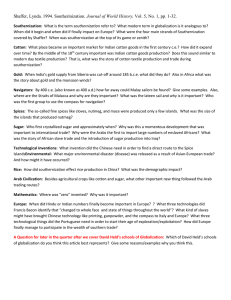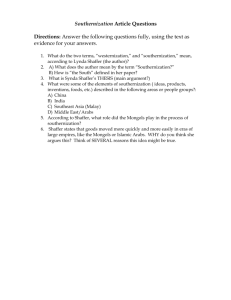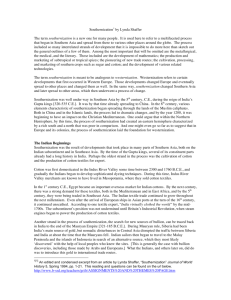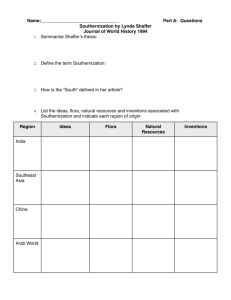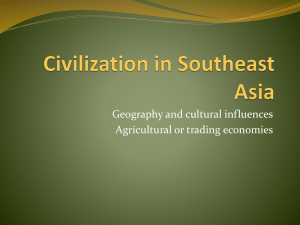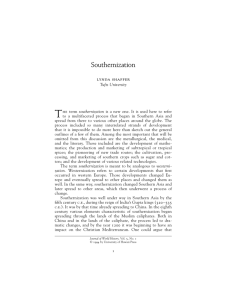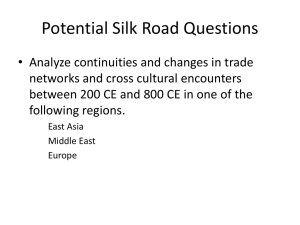South Asia`s Influence on History: Article
advertisement
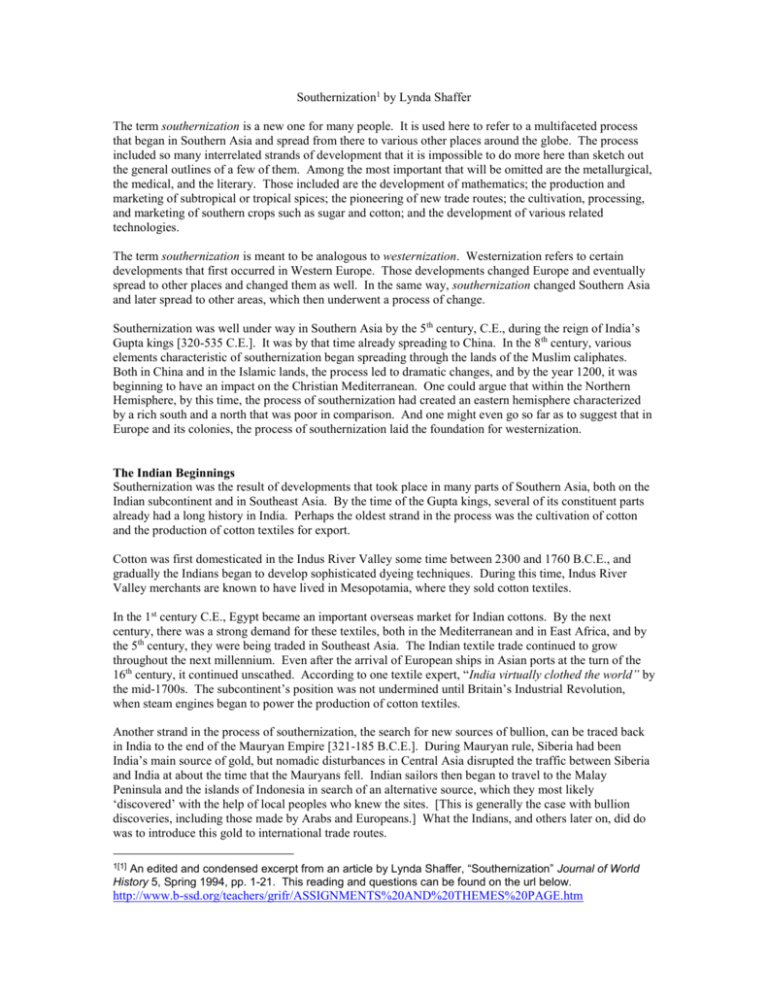
Southernization1 by Lynda Shaffer The term southernization is a new one for many people. It is used here to refer to a multifaceted process that began in Southern Asia and spread from there to various other places around the globe. The process included so many interrelated strands of development that it is impossible to do more here than sketch out the general outlines of a few of them. Among the most important that will be omitted are the metallurgical, the medical, and the literary. Those included are the development of mathematics; the production and marketing of subtropical or tropical spices; the pioneering of new trade routes; the cultivation, processing, and marketing of southern crops such as sugar and cotton; and the development of various related technologies. The term southernization is meant to be analogous to westernization. Westernization refers to certain developments that first occurred in Western Europe. Those developments changed Europe and eventually spread to other places and changed them as well. In the same way, southernization changed Southern Asia and later spread to other areas, which then underwent a process of change. Southernization was well under way in Southern Asia by the 5 th century, C.E., during the reign of India’s Gupta kings [320-535 C.E.]. It was by that time already spreading to China. In the 8 th century, various elements characteristic of southernization began spreading through the lands of the Muslim caliphates. Both in China and in the Islamic lands, the process led to dramatic changes, and by the year 1200, it was beginning to have an impact on the Christian Mediterranean. One could argue that within the Northern Hemisphere, by this time, the process of southernization had created an eastern hemisphere characterized by a rich south and a north that was poor in comparison. And one might even go so far as to suggest that in Europe and its colonies, the process of southernization laid the foundation for westernization. The Indian Beginnings Southernization was the result of developments that took place in many parts of Southern Asia, both on the Indian subcontinent and in Southeast Asia. By the time of the Gupta kings, several of its constituent parts already had a long history in India. Perhaps the oldest strand in the process was the cultivation of cotton and the production of cotton textiles for export. Cotton was first domesticated in the Indus River Valley some time between 2300 and 1760 B.C.E., and gradually the Indians began to develop sophisticated dyeing techniques. During this time, Indus River Valley merchants are known to have lived in Mesopotamia, where they sold cotton textiles. In the 1st century C.E., Egypt became an important overseas market for Indian cottons. By the next century, there was a strong demand for these textiles, both in the Mediterranean and in East Africa, and by the 5th century, they were being traded in Southeast Asia. The Indian textile trade continued to grow throughout the next millennium. Even after the arrival of European ships in Asian ports at the turn of the 16th century, it continued unscathed. According to one textile expert, “India virtually clothed the world” by the mid-1700s. The subcontinent’s position was not undermined until Britain’s Industrial Revolution, when steam engines began to power the production of cotton textiles. Another strand in the process of southernization, the search for new sources of bullion, can be traced back in India to the end of the Mauryan Empire [321-185 B.C.E.]. During Mauryan rule, Siberia had been India’s main source of gold, but nomadic disturbances in Central Asia disrupted the traffic between Siberia and India at about the time that the Mauryans fell. Indian sailors then began to travel to the Malay Peninsula and the islands of Indonesia in search of an alternative source, which they most likely ‘discovered’ with the help of local peoples who knew the sites. [This is generally the case with bullion discoveries, including those made by Arabs and Europeans.] What the Indians, and others later on, did do was to introduce this gold to international trade routes. An edited and condensed excerpt from an article by Lynda Shaffer, “Southernization” Journal of World History 5, Spring 1994, pp. 1-21. This reading and questions can be found on the url below. 1[1] http://www.b-ssd.org/teachers/grifr/ASSIGNMENTS%20AND%20THEMES%20PAGE.htm The Indians’ search for gold may also have led them to the shores of Africa. Although its interpretation is controversial, some archaeological evidence suggests the evidence of Indian influence on parts of East Africa as early as 300 C.E. There is also one report that gold was being sought in East Africa by Ethiopian merchants, who were among India’s most important trading partners. The 6th century Byzantine geographer Cosmas Indicopleustes described Ethiopian merchants who went to some location inland from the East African coast to obtain gold. “Every other year they would sail far to the south, then march inland, and in return for various made-up articles they would come back laden with ingots of gold.” The fact that the expeditions left every other year suggests that it took 2 years to get to their destination and return. If so, their destination, even at this early date, may have been Zimbabwe. The wind patterns are such that sailors who ride the monsoon south as far as Kilwa can catch the return monsoon to the Red Sea areas within the same year. However, if they go beyond Kilwa to the Zambezi River, from which they might go inland to Zimbabwe, they cannot return until the following year. Indian voyages on the Indian Ocean were part of a more general development, more or less contemporary with the Mauryan Empire, in which sailors of various nationalities began to knit together the shores of the “Southern Ocean”, a Chinese term referring to all the waters from the South China Sea to the eastern coast of Africa. During the period, there is no doubt that the most intrepid sailors were the Malays, peoples who lived in what is now Malaysia, Indonesia, the southeastern coast of Vietnam, and the Philippines. Sometime before 300 B.C.E., Malay sailors began to ride the monsoons, the seasonal winds that blow off the continent of Asia in the colder months and onto its shores in the warmer months. Chinese records indicate that by the 3rd century B.C.E., “Kunlun” sailors [the Chinese term for Malay seamen] were sailing north to the southern coasts of China. They may also have been sailing east to India, through the straits now called Malacca and Sunda. If so, they may have been the first to establish contact between India and Southeast Asia. Malay sailors had reached the eastern coast of Africa at least by the 1 st century B.C.E., if not earlier. Their presence in East African waters is testified to by the peoples of Madagascar, who still speak a MalayPolynesian language. Some evidence also suggests that Malay sailors had settled in the Red Sea area. Indeed, it appears that they were the first to develop a long-distance trade in a southern spice. In the last century B.C.E., if not earlier, Malay sailors were delivering cinnamon from South China Sea ports to East Africa and the Red Sea. By about 400 C.E., Malay sailors could be found 2/3 rds of the way around the world, from Easter Island to East Africa. They rode the monsoons without a compass, out of sight of land, and often at latitudes below the equator where the northern pole star cannot be seen. They navigated by the wind and the stars, by cloud formations, the color of the water, and swell and wave patterns on the ocean’s surface. They could discern the presence of an island some 30 miles from its shore by noting the behavior of the birds, the animal and plant life in the water, and the swell and wave patterns. Given their manner of sailing, their most likely route to Africa and the Red Sea would have been by way of the island clusters, the Maldives, the Seychelles, etc. Malay ships used balance lug sails, which were square in shape and mounted so that they could pivot. This made it possible for sailors to tack against the wind, that is, to sail into the wind by going diagonally against it, first one way and then the other. Due to the way the sails were mounted, they appeared triangular in shape, and thus may be the prototype of the Arab triangular sails which were then used to tack against the wind. Indian traders and shippers and Malay sailors were also responsible for opening up an all-sea route to China. The traders’ desire for silk drew them out into dangerous waters in search of a more direct way to its sources. By the 2nd century C.E., Indian merchants could make the trip by sea, but the route was slow, and it took at lest 2 years to make a round trip. Merchants leaving from India’s eastern coast rounded the shores of the Bay of Bengal and went on to the coast of Vietnam and on to China with the monsoon winds. It was also during this time period that the Indians discovered how to crystallize sugar. There is considerable disagreement about where sugar was first domesticated. Some believe that the plant was native to New Guinea and domesticated there, and others argue that it was domesticated by Southeast Asian peoples living in what is now southern China. In any case, sugar cultivation spread to the Indian subcontinent. Sugar, however, did not become an important item of trade until the Indians discovered how to turn sugarcane juice into granulated crystals that could be easily stored and transported. This was a momentous development, and it may have been encouraged by Indian sailing, for sugar and clarified butter [ghee] were among the dietary mainstays of Indian sailors. The Indians also laid the foundation for modern mathematics during the time of the Gupta Empire. Western numerals, which the Europeans called Arabic since they acquired them from the Arabs, actually came from India. The Arabs still call them ‘Hindi’ numbers. The most significant feature of the Indian system was the invention of the zero as a number concept. The oldest existing work that used the zero in the modern way is a mathematical work attached to a text on astronomy, which is dated 499 C.E. The Indian zero made the place value system of writing numbers superior to all others. Without it, the use of this system, base ten or otherwise, was fraught with difficulties and did not seem any better than alternative systems. With the zero, the Indians were able to perform calculations rapidly and accurately, to perform much more complicated calculations, and to discern mathematical relationships more aptly. These numerals, and the mathematics the Indians developed with them, are now universal – just one indication of the global significance of southernization. As a result of these developments, India acquired a reputation as a place of marvels, a reputation that was maintained for many centuries after the Gupta dynasty fell. As late as the 9 th century, Amr ibn Bahr al Jahiz [c. 776-868], one of the most influential writers of Arabic, had the following to say about India: “As regards the Indians, they are among the leaders in astronomy, mathematics – in particular, they have Indian numerals – and medicine; they alone possess the secrets of the latter, and use them to practice some remarkable forms of treatment. They have the art of carving statues and painted figures. They possess the game of chess, which is the noblest of games. They make swords, and excel in their use. They have splendid music. They possess a script capable of expressing the sounds of all languages, as well as many numerals. They have a great deal of poetry, many long treatises, and a deep understanding of philosophy and letters. They are intelligent and courageous. Their sound judgment and sensible habits led them to invent pins, cork, toothpicks, and the dyeing of hair. They were the inventors of astronomical reckoning which was subsequently adopted by the rest of the world. When Adam descended from Paradise, it was to their land that he made his way.” The Southernization of China These Southern Asian developments began to have a significant impact on China after 350 C.E. The Han dynasty had fallen in China in 221 C.E., and for more than 350 years thereafter, China was ruled by an ever-changing collection of regional kingdoms. During these centuries in which Buddhism became increasingly important in China, Buddhist monasteries spread throughout the disunited realm, and cultural exchange between India and China grew accordingly. By 581, when the Chinese empire was reunited under the Sui dynasty, processes associated with southernization had already had a major impact on China. The influence of southernization continued during the Tang dynasty [618-906] and the Song dynasty [9601279]. One might even go so far as to suggest that the process of southernization underlay the revolutionary social, political, economic, and technological developments of the Tang and Song. The Chinese reformed their mathematics, incorporating the advantages of the Indian system, even though they did not adopt the Indian numerals at that time. They then went on to develop an advanced mathematics, which was flourishing by the time of the Song dynasty. Cotton and indigo became well established, giving rise to the blue-black peasant garb that is became common in China. Also in the Song period, the Chinese first developed cotton canvas, which they used to make a more efficient sail for oceangoing ships. Although sugar had long been grown in some parts of southern China, it did not become an important crop in this region until the process of southernization was well under way. The process also introduced new varieties of rice. The most important of these was what the Chinese called “Champa rice”, since it came to China from Champa, a Malay kingdom located on what is now the southern coast of Vietnam. Champa rice was a drought-resistant, early ripening variety that made it possible to extend cultivation up wellwatered hillsides, thereby doubling the area of rice cultivation in China. In southern China, the further development of rice production brought significant changes in the landscape. Before the introduction of Champa rice, rice cultivation had been confined to lowlands, deltas, basins, and river valleys. Once Champa rice was introduced and rice cultivation spread up the hillsides, the Chinese began systematic terracing and made use of sophisticated techniques of water control on mountain slopes. Between the mid-8th and early 12th century, the population of southern China tripled, and the total Chinese population doubled. According to the Song dynasty household registration figures for the 1100’s, there were 100 million people in China by the 1st decade of the 12th century. Before the process of southernization, northern China had always been predominant, intellectually, socially, and politically. The imperial center of gravity was clearly in the north, and the southern part of China was perceived as a frontier area. However, southernization changed this situation dramatically. By 600, southern China was well on its way to becoming the most prosperous and most commercial part of the empire. The most telling evidence for this is the construction of the Grand Canal, which was completed around 610, during the Sui Dynasty. Even though the rulers of the Sui dynasty had managed to put the pieces of the empire back together, and rule the whole of China again from a single northern capital, they were dependent on the new southern crops. Thus it is no coincidence that this dynasty felt the need to build a canal that could deliver southern rice to northern cities, and northern military regiments to the south. The Tang dynasty, when Buddhist influence in China was especially strong, saw two exceedingly important technological innovations – the invention of printing and gunpowder. These developments may also be linked to southernization. Printing seems to have developed within the walls of Buddhist monasteries between 700 and 750, and southwestern China was one of the earliest centers of the art. The invention of gunpowder in China by Taoist alchemists in the 9th century may also be related to the linkages between India and China created by Buddhists. In 644, an Indian monk identified soils in China that contained saltpeter and demonstrated the purple flame that results from its ignition. As early as 919 C.E., gunpowder was used as an igniter in a flamethrower, and the 10 th century also saw the use of flaming arrows, rockets, and bombs thrown by catapults. By the time of the Song dynasty, the Chinese also had perfected the ‘south-pointing needle,’ otherwise known as the compass. Various prototypes of the compass had existed in China from the 3 rd century B.C.E., but the new version developed during the Song dynasty was particularly well suited for navigation. Soon Chinese mariners were using the south-pointing needle on the oceans, publishing ‘needle charts’ for the benefit of the sea captains, and following ‘needle routes’ on the Southern Ocean. Once the Chinese had the compass, they, like Columbus, set out to find a direct route to the spice markets of Southeast Asia. Unlike Columbus, they found them. They did not bump into an obstacle, now known as the Western Hemisphere, on their way, since it was not located between China and the Spice Islands. If it had been so situated, the Chinese would have found it some 500 years before Columbus. Cities on China’s southern coast became centers of overseas commerce. Silk remained an important export, and by the Tang dynasty it had been joined by porcelain, which was developed in China sometime before 400 C.E. China’s southern ports were also exporting to Southeast Asia large quantities of ordinary consumer goods, including iron hardware, such as needles, scissors, and cooking pots. Until the British Industrial Revolution of the 18th century, no other place equaled the iron production of Song China. The Islamic Caliphates [Empires] In the 7th century C.E., Arab cavalries, recently converted to the new religion of Islam, conquered eastern and southern Mediterranean shores that had been Byzantine [and Christian], as well as the Persian empire of what is now Iraq and Iran. In the 8 th century they went on to conquer Spain and Turkish areas of Central Asia, as well as northwestern India. Once established on the Indian frontier, they became acquainted with many of the elements of southernization. The Arabs were responsible for the spread of many important crops, developed or improved in India, to the Middle East, North Africa, and Islamic Spain. Among the most important were sugar, cotton, and citrus fruits. Although sugarcane and cotton cultivation may have spread to Iraq and Ethiopia before the Arab conquests, only after the establishment of the caliphates did these southern crops have a major impact throughout the Middle East and North Africa. The Arabs were the first to import large numbers of enslaved Africans in order to produce sugar. Fields at the northern end of the Persian Gulf were the most important sugar-producing areas within the caliphates, but before this land could be used, it had to be desalinated. To accomplish this task, the Arabs imported East African slaves. The Arabs were responsible for moving sugarcane cultivation and sugar manufacturing westward from southern Iraq into other relatively arid lands. Growers had to adapt the plant to new conditions, and they had to develop more efficient irrigation technologies. By 1000 or so, sugarcane had become an important crop in much of the Middle East and Spain. By this time, cotton had also become a major crop in the Islamic empires, with cotton industries producing for both local and distant markets. Under Arab auspices, Indian mathematicians followed the same routes as the crops. By 825, mathematicians within the Islamic empires drew upon the Indian tradition, as well as the Greek and Persian. On this foundation, Muslim scientists of many nationalities made remarkable advances in both algebra and trigonometry. The Arab conquests also led to an increase in long-distance commerce and the ‘discovery’ of new sources of bullion. Soon after the Abbasid caliphate established its capital at Baghdad in the 700s, the caliph remarked, “This is the Tigris River; there is no obstacle between us and China; everything on the sea can come to us.” By this time, Arab ships were plying the maritime routes from the Persian Gulf to China, and they soon outnumbered all others using these routes. By the 9 th century they had acquired the compass [in China, most likely], and they may well have been the first to use it for marine navigation, since the Chinese do not seem to have used it for this purpose until after the 10 th century. Conclusion By 1200, the process of southernization had created a prosperous south from China to the Islamic Mediterranean, based on mathematics, the pioneering of new ocean routes and ‘discoveries’ of bullion and crops such as sugar, cotton and spices. In the 17th century, Francis Bacon singled out three technologies that changed the face and state of things throughout the world. These were all Chinese inventions – the compass, printing and gunpowder. It is most likely that the Arabs introduced the compass into Mediterranean waters. Block printing and gunpowder appeared first in Italy in the 1300s, probably through the Mongols. The rise of Europe’s northwest began with the appropriation of those elements of southernization that were not confined by geography. In the wake of their southern European neighbors, they became partially southernized, but they could not engage in all aspects of the process due to their distance from the tropical sources of cotton, sugar and spices. Full southernization, and the wealth we now associate with northwestern Europe, came about only after their outright seizure of tropical and subtropical territories as they rounded Africa and participated in the Southern Ocean trade. In conclusion, many scholars now argue that Europe’s northwest did not rise until it was reaping the profits of southernization. Therefore, the rise of the North Atlantic powers should not be oversimplified so that it appears to be an isolated and solely European phenomenon, with roots that spread no farther afield than Greece. Rather, it should be portrayed as one part of a hemisphere-wide process, in which a northwestern Europe ran to catch up with a more developed south – a race not completed until the 18th century. Questions for Shaffer’s Article on “Southernization” 1. What is Ms. Shaffer’s thesis in the article? 2. What does the author mean by “Southernization”? 3. How is the “South” defined in her article? 4. List the ideas, the agricultural, mineral, and manufactured products and the inventions that she associates with “Southernization.” 5. What places were the ideas, agriculture, minerals, and manufactured products associated with. 6. What were the major contributions of Indians, Malays, Chinese, and Arabs to hemispheric development? 7. According Shaffer, what role did the Arabs and Mongols play in the spread of “Southernization”? 8. Why does she say that northwestern Europeans were most fully participating in the “Southernization” process only after they acquired tropical colonies? 9. Do you agree with her thesis? Why or why not?
